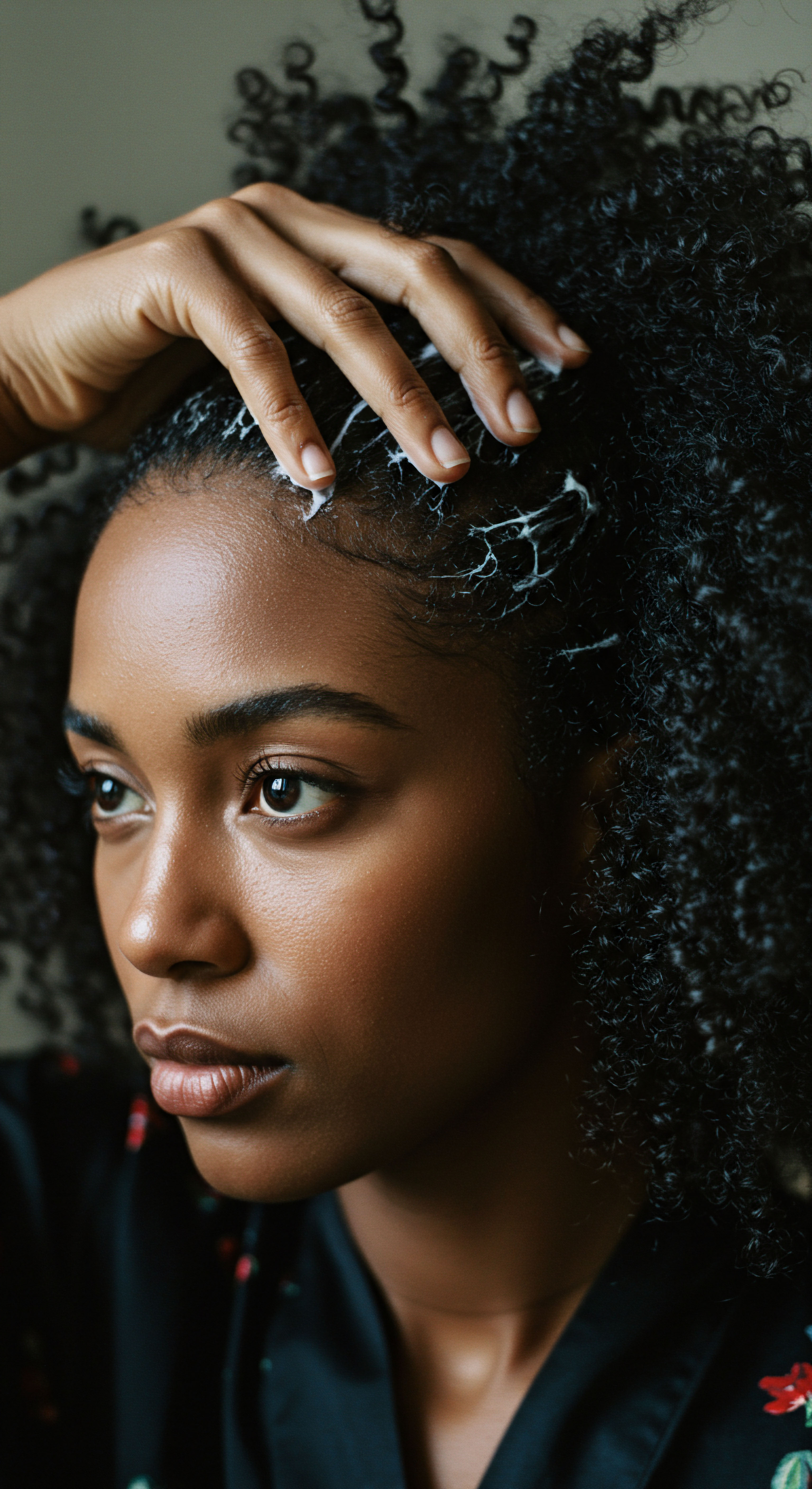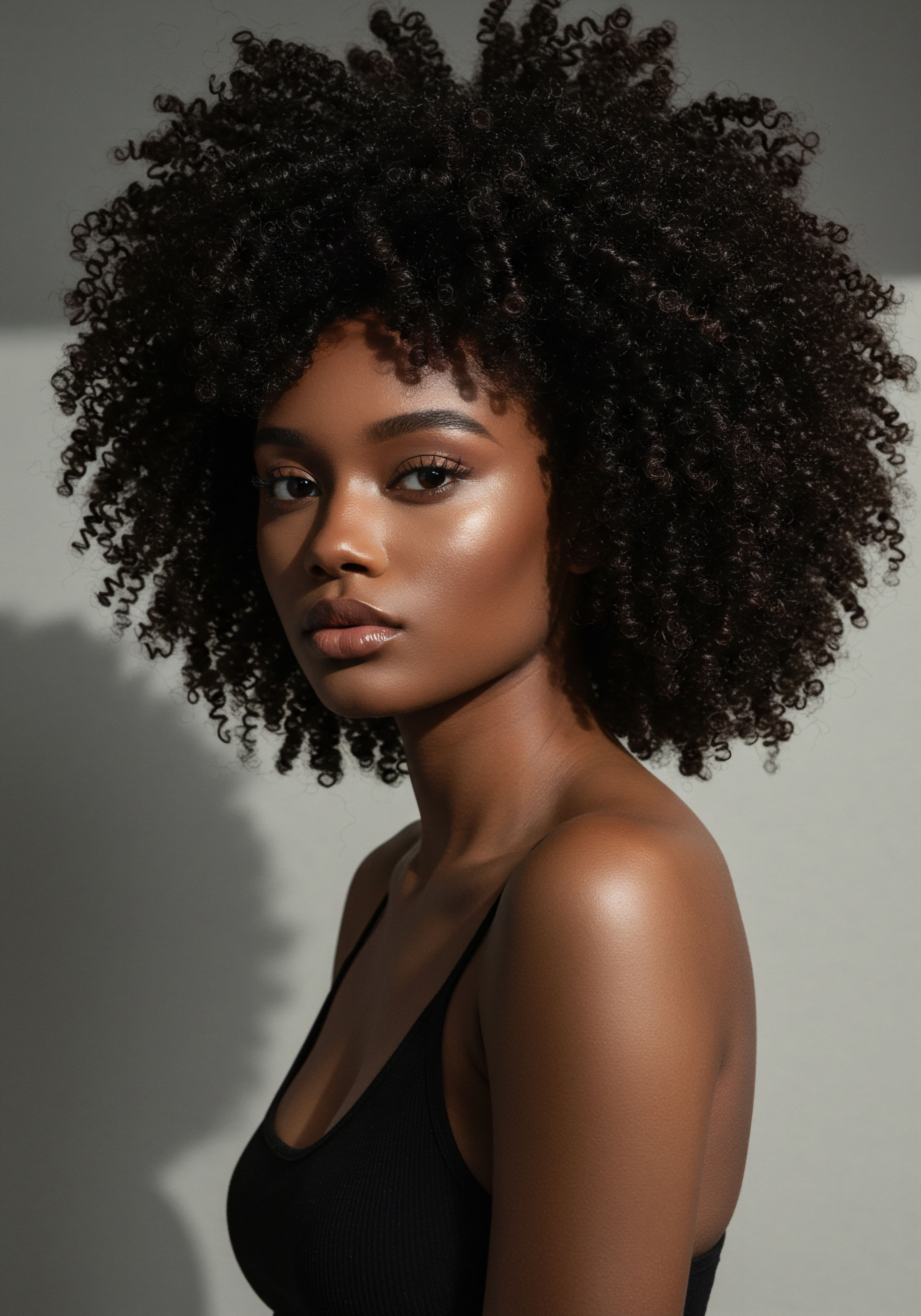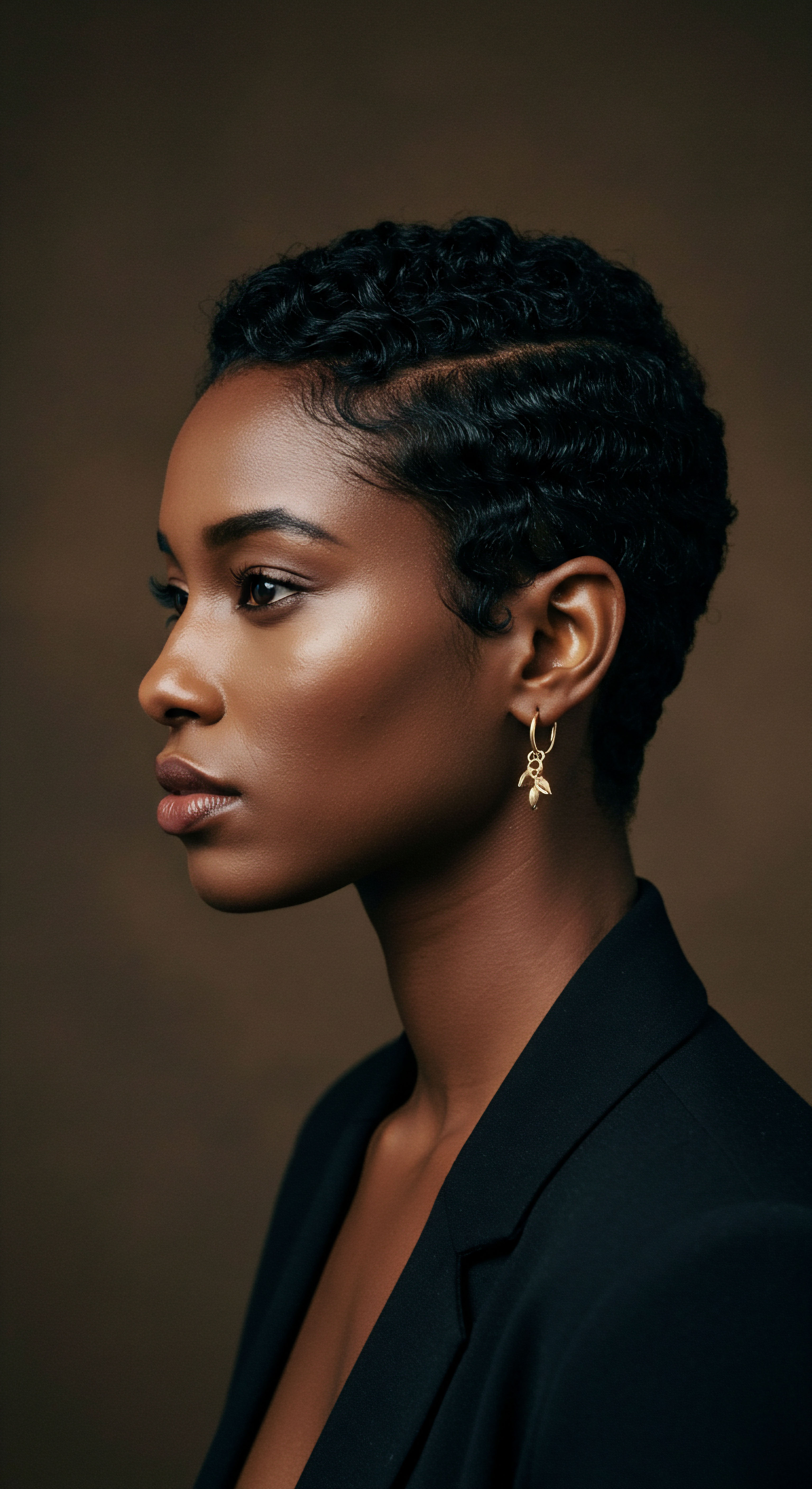
Roots
The quiet hum of life beneath our textured crowns often goes unnoticed, yet it orchestrates the very vibrancy we seek in our strands. We speak of the scalp, a delicate landscape, a foundation upon which our hair’s story unfolds. This intricate skin, so often a canvas for styling and product, harbors a deeper, unseen activity.
It is within this living terrain that the hormone melatonin, known for its gentle lullaby to our sleep cycles, plays a lesser-sung, yet profoundly significant, role. The distinctions between introducing melatonin to this ecosystem through a direct touch or through the body’s internal currents are not merely procedural; they speak to the very language our follicles understand.
Consider the rhythm of growth, the ebb and flow of our hair’s existence. Every strand begins its journey in a tiny pocket within the scalp, a follicle. These follicles do not merely grow; they cycle through phases of energetic growth, a brief pause, and then a quiet rest before a new cycle begins. This dance of cellular life is influenced by a symphony of internal signals, among them, melatonin.
Its presence in the skin itself, beyond the pineal gland, suggests a local conversation, a direct whisper to the very cells responsible for hair formation. This local synthesis, particularly within the mitochondria of skin cells, serves as a frontline defense against environmental stressors, protecting the delicate machinery of hair production.

The Scalp’s Silent Symphony
Our scalp, often considered simply a canvas for our hair, is a complex biological system, a living skin barrier. It possesses its own circadian rhythms, its own unique set of cells and processes that contribute to hair health. The dermal papilla, a cluster of cells at the base of the hair follicle, acts as a command center, sending signals that dictate hair growth.
Melatonin receptors are present in these dermal papilla cells, indicating a direct pathway for melatonin to influence hair growth at its very source. This local presence and receptor activity suggest a direct line of communication, a subtle yet powerful interaction that transcends the body’s broader systemic messages.
The scalp, a vibrant ecosystem, communicates with melatonin through specialized receptors within its hair follicles, signaling a localized influence on growth.

Melatonin’s Ancient Whispers
Melatonin, while recognized for its role in regulating our sleep-wake cycles, holds a deeper, more ancient connection to biological rhythms, including those of hair growth. Across various species, melatonin has been observed to modulate hair growth and molting, aligning coat phenotypes with seasonal changes. This biological heritage hints at a fundamental role in regulating cellular activity and protecting against oxidative stress, a process that can damage hair follicles.
The skin, remarkably, is not only a target for melatonin’s actions but also an extra-pineal site where it is synthesized, regulated, and metabolized. This self-sufficiency underscores its importance in local skin and hair health.

Hair Follicle’s Rhythmic Dance
The life of a hair strand follows a predictable, yet delicate, rhythm. The Anagen Phase marks a period of active growth, where cells divide rapidly, pushing the hair shaft outward. This is followed by the Catagen Phase, a brief transitional period, and then the Telogen Phase, a resting stage before the old hair sheds and a new one begins its journey.
Melatonin has been shown to influence this cycle by prolonging the anagen phase and delaying the onset of the catagen and telogen phases. This effect is particularly significant for individuals experiencing hair thinning or loss, as a longer growth phase means more time for hair to grow, leading to greater density.
- Anagen Phase ❉ The active growth stage where hair cells divide swiftly.
- Catagen Phase ❉ A brief, transitional stage where hair growth halts.
- Telogen Phase ❉ The resting stage, leading to hair shedding.
The hair follicle itself acts as a miniature organ, capable of synthesizing melatonin. This local production, particularly within the metabolically active anagen hair bulb, serves as a self-protective strategy, combating oxidative stress and promoting cellular health. This intricate local system provides a foundation for understanding how both external and internal melatonin might interact with our scalp’s unique biology.

Ritual
As we move from the quiet understanding of our scalp’s inner workings, we find ourselves at the threshold of daily practices, the thoughtful applications that shape our hair’s journey. The desire for vibrant, healthy hair often leads us to consider various remedies, and melatonin has certainly stepped into this arena. The practical wisdom here lies in discerning how this gentle hormone, whether offered as a topical caress or an internal supplement, integrates into the rhythm of our hair care. Each approach presents its own cadence, its own dialogue with our strands, and understanding these distinctions guides us toward a more harmonious relationship with our crowns.
The choice between a topical application and an oral supplement of melatonin for scalp health presents a fascinating study in delivery systems. One directly addresses the scalp’s surface, while the other navigates the body’s systemic pathways. Both methods seek to influence the hair follicle, yet their routes of action and potential effects diverge, inviting a deeper consideration of their individual merits within a thoughtful hair care regimen.

A Gentle Scalp Anointing
Applying melatonin directly to the scalp, often in the form of a serum or solution, offers a localized approach. This method seeks to deliver the hormone directly to the hair follicles, where its receptors are concentrated. Topical formulations are typically designed to be absorbed through the skin, allowing melatonin to act directly on the follicular cells without first passing through the digestive system and liver.
This direct delivery can mean a more immediate, concentrated effect on the scalp’s specific needs. Studies have often used concentrations ranging from 0.0033% to 0.1% applied once daily.
The simplicity of this ritual, often a few drops massaged into the scalp, belies its potential for targeted action. The thought is that by applying melatonin where it is needed most, its benefits can be maximized for the hair follicles.
Topical melatonin offers a direct conversation with hair follicles, bypassing systemic pathways for localized influence.

A Quiet Evening’s Sip
Oral melatonin, traditionally taken to support sleep cycles, introduces the hormone into the body’s systemic circulation. Once ingested, melatonin is absorbed through the digestive tract and metabolized by the liver before reaching the bloodstream. This means a broader distribution throughout the body, with potential effects on various physiological processes, including sleep, mood, and antioxidant defense.
While some of this circulating melatonin will reach the scalp and hair follicles, its concentration and directness of action at the follicular level may differ from topical application. Standard oral dosages for hair health, when studied, have been around 1.5 mg twice daily.
The systemic influence of oral melatonin means that its effects on hair health may be part of a wider physiological recalibration, potentially addressing underlying systemic imbalances that contribute to hair concerns.

Weighing the Pathways
The distinctions between these two delivery methods extend beyond mere application. Topical melatonin, due to its direct contact with the scalp, typically presents a lower risk of systemic side effects, such as drowsiness, which can be a concern with oral intake. However, localized reactions like skin reddening or sensitivity might occur. Oral melatonin, conversely, can affect the entire body, and its impact on sleep should always be considered.
| Aspect Delivery Method |
| Topical Melatonin Direct application to scalp |
| Oral Melatonin Ingested, absorbed systemically |
| Aspect Targeted Action |
| Topical Melatonin Primarily localized to hair follicles |
| Oral Melatonin Systemic distribution, then to follicles |
| Aspect Absorption Route |
| Topical Melatonin Percutaneous absorption |
| Oral Melatonin Gastrointestinal absorption, hepatic metabolism |
| Aspect Side Effects |
| Topical Melatonin Localized irritation, sensitivity |
| Oral Melatonin Drowsiness, systemic interactions |
| Aspect Understanding the distinct routes helps tailor melatonin use for individual needs. |
A comprehensive review of 11 human studies on melatonin for hair loss, involving over 2,200 patients, revealed compelling insights. Eight of these studies observed positive outcomes with topical melatonin for androgenetic alopecia, showing improved scalp hair growth, density, and shaft thickness. While oral supplementation also yielded positive results, the direct application appears to offer a more targeted and often preferred method for localized scalp concerns. This suggests that for those whose primary concern is hair health, a topical approach may offer a more direct and efficient route to the hair follicle itself.

Relay
To truly comprehend the choices before us, we must delve into the intricate dialogue between our body’s internal rhythms and the whispers we offer our scalp from the outside. The application of melatonin, whether a direct touch or an internal journey, initiates a cascade of biological responses. How do these distinct pathways ultimately converge, or diverge, in their influence on the delicate ecosystem of our hair follicles? This consideration moves beyond simple application, inviting us to contemplate the profound interplay of systemic and localized effects, a dance of chemistry and biology that shapes our hair’s vitality.
The distinction between topical and oral melatonin for scalp health rests upon fundamental differences in pharmacokinetics and the specific cellular interactions each method facilitates. While both aim to deliver melatonin to the hair follicle, their routes to this destination are profoundly different, influencing efficacy, potential systemic impact, and overall suitability for diverse needs.

The Body’s Inner Channels
When melatonin is taken orally, it enters the bloodstream after digestion and absorption, becoming subject to the body’s systemic processes. A significant portion of ingested melatonin undergoes what is known as first-pass metabolism in the liver. This means that a considerable amount of the active compound is broken down before it even reaches the general circulation, leading to a variable and often low bioavailability. For example, the oral bioavailability of melatonin can be as low as 15% for typical dosages.
This widespread distribution means melatonin reaches every tissue with melatonin receptors, including those in the brain, influencing sleep, mood, and other systemic functions. While beneficial for overall wellness, this systemic route means the concentration reaching the scalp might be diluted compared to a direct topical application.
The impact of oral melatonin on hair growth is therefore an indirect one, relying on the hormone’s systemic presence to influence follicular activity. Its antioxidant and anti-inflammatory properties, when distributed throughout the body, can contribute to overall cellular health, which in turn supports hair follicle function.
Oral melatonin, while systemically beneficial, faces metabolic hurdles, potentially diluting its direct impact on scalp follicles.

A Follicle’s Direct Dialogue
Topical melatonin, by contrast, seeks a more direct conversation with the hair follicle. When applied to the scalp, melatonin penetrates the skin barrier, aiming to reach the dermal papilla cells and other follicular structures where its receptors (MT1 and MT2) are abundant. The skin itself is capable of synthesizing melatonin, and its concentration in human scalp hair follicles has been reported to be higher than in serum, suggesting a local regulatory role. This local absorption minimizes systemic exposure and bypasses the first-pass metabolism in the liver, theoretically allowing for higher concentrations at the target site—the hair follicle.
Research indicates that topical melatonin can directly stimulate hair follicle cells. For instance, a study using a 0.1% melatonin solution applied once daily for six months demonstrated a significantly increased anagen hair rate in women with androgenetic alopecia, particularly in the occipital region. This localized effect points to a more targeted approach for specific scalp concerns.

How Melatonin Reaches Hair Cells
The journey of melatonin to the hair follicle differs profoundly based on its application.
- Topical Absorption ❉ Melatonin, being a small, amphiphilic molecule, can penetrate the stratum corneum, the outermost layer of the skin. Once through this barrier, it can interact directly with the melatonin receptors present in the dermal papilla, outer and inner root sheaths, and other cells within the hair follicle. This direct delivery is thought to promote cell division in the hair follicle and prolong the anagen (growth) phase.
- Oral Absorption ❉ After ingestion, melatonin is absorbed from the gastrointestinal tract into the portal circulation, where it is extensively metabolized by the liver. The remaining melatonin then enters the systemic circulation, distributing throughout the body, including the scalp. The effects on hair follicles are thus mediated through circulating levels, which are lower and more variable due to hepatic metabolism.
A particularly intriguing aspect of melatonin’s influence on hair is its anti-androgenic effect. Melatonin can influence androgen receptors, potentially reducing the impact of male hormones that contribute to conditions like androgenetic alopecia. This mechanism appears to be active with both topical and oral applications, but the directness of topical delivery may offer a more concentrated influence on these receptors within the follicle itself.

Melatonin’s Dual Mechanism
Melatonin’s beneficial effects on hair growth are attributed to two primary mechanisms:
- Antioxidant Properties ❉ Melatonin is a potent antioxidant, capable of neutralizing free radicals that cause oxidative stress and damage to hair follicle cells. This protective action helps preserve the integrity of the follicle and reduces premature hair loss. This benefit applies to both topical and oral forms, as melatonin’s antioxidant effects are widespread.
- Hair Cycle Modulation ❉ Melatonin directly influences the hair growth cycle by prolonging the anagen phase and delaying the transition to the catagen and telogen phases. This extends the period of active growth, leading to increased hair density and reduced shedding. The presence of melatonin receptors in hair follicles underscores this direct regulatory role.
A noteworthy finding from a 2023 review of 11 human studies, involving 2,267 patients, indicated that eight of these studies observed positive outcomes with topical melatonin use in subjects with androgenetic alopecia (AGA). These outcomes included improved scalp hair growth, density, and hair shaft thickness compared to controls. The review suggested effective topical dosages of 0.0033% or 0.1% applied once daily for 90 to 180 days, compared to 1.5 mg twice-daily oral supplementation for 180 days. This particular finding highlights a strong case for the targeted effectiveness of topical application in specific hair loss patterns.

Beyond the Science ❉ A Cultural Lens
The choice between topical and oral approaches also carries a subtle cultural resonance. For generations, remedies for hair and scalp concerns have been rooted in direct application—oils, herbs, and concoctions massaged into the scalp. This tactile, ritualistic approach aligns with a historical understanding of localized care, a belief in the power of direct touch and focused attention. Oral remedies, while equally valid, often speak to a broader systemic rebalancing, a recognition of the interconnectedness of internal health and external presentation.
The modern understanding of melatonin bridges these perspectives, offering scientific validation to both. Topical applications honor the tradition of direct scalp care, while oral supplements acknowledge the systemic influences on hair health. For textured hair, where the scalp often requires specific attention due to styling practices or environmental exposures, the localized benefits of topical melatonin can be particularly appealing. It offers a way to directly nourish and protect the follicles at their most vulnerable point, supporting the strength and resilience of each curl and coil.

Reflection
As our exploration of melatonin’s dance with scalp health draws to a gentle close, we find ourselves at a quiet crossroads. The journey has revealed not a singular path, but a landscape of possibilities, each with its own rhythm and resonance. Whether through the direct, nurturing touch of a topical serum or the systemic, balancing influence of an oral supplement, melatonin offers a unique conversation with our hair follicles.
The decision rests not on a definitive “better,” but on a thoughtful consideration of individual needs, the particular whispers our scalp may be speaking, and the harmony we seek to cultivate within our own hair care story. This is a personal dialogue, a continued listening to the subtle shifts and desires of our crowns, always with the understanding that true radiance springs from both intentional care and a deep, grounded presence.

References
- Chen, C. Chen, S. Zhang, C. et al. (2024). Melatonin’s Role in Hair Follicle Growth and Development ❉ A Cashmere Goat Perspective. Journal of Animal Science and Biotechnology, 15(1), 1-15.
- Babadjouni, A. Reddy, M. Zhang, R. et al. (2023). Melatonin and the Human Hair Follicle. Journal of Drugs in Dermatology, 22(3), 260-264.
- Healthline. (2024). Does Melatonin Cause Hair Loss? What Research Shows. Healthline Media.
- Fischer, T. W. Kleszczynski, K. & Hardkop, L. H. (2012). Clinical Studies Using Topical Melatonin. MDPI Pharmaceuticals, 5(1), 1-18.
- Corti Hormonal Research. (2023). Melatonin ❉ A Game-Changer for Hair Growth and Health. Corti Hormonal Research.
- Milani, M. & Fischer, T. W. (2012). Melatonin and Hair Physiology ❉ Reasons and Clinical Efficacy Data as a Topical Treatment of Androgenic Alopecia. Medigraphic International Journal of Trichology, 4(4), 30-36.
- Birmingham Dermatology Clinic. (2024). Melatonin Stopping Hair Loss? Birmingham Dermatology Clinic.
- Fischer, T. W. Burmeister, G. Schmidt, H. W. & Elsner, P. (2004). Melatonin increases anagen hair rate in women with androgenetic alopecia or diffuse alopecia ❉ results of a pilot randomized controlled trial. British Journal of Dermatology, 150(2), 341-345.
- The Role of Melatonin in Hair and Scalp Care. (2024). Trichology Review Journal, 7(2), 45-52.
- Fischer, T. W. Slominski, A. Tobin, D. J. & Paus, R. (2008). Melatonin and the Hair Follicle. Journal of Pineal Research, 44(1), 1-15.
- Hair Loss Solutions. (2024). Exploring Melatonin as a Potential Solution for Hair Loss. Journal of Hair Science, 12(3), 87-95.
- Healthshots. (2024). Melatonin for Hair Growth ❉ Benefits and Side Effects. Healthshots.
- International Journal of Trichology. (2012). Topical Melatonin for Treatment of Androgenetic Alopecia. International Journal of Trichology, 4(4), 236-245.
- Babadjouni, A. Reddy, M. & Zhang, R. (2023). Melatonin and the Human Hair Follicle. Journal of Drugs in Dermatology, 22(3), 260-264.
- Fischer, T. W. Burmeister, G. Schmidt, H. W. & Elsner, P. (2004). Melatonin increases anagen hair rate in women with androgenetic alopecia or diffuse alopecia ❉ results of a pilot randomized controlled trial. British Journal of Dermatology, 150(2), 341-345.
- Ali, A. M. & Hameed, Z. A. (2018). Effect of Topically Applied Melatonin and Their Combination With Minoxidil Solution For Enhancement of Hair Growth In Male Mice. Systematic Reviews in Pharmacy, 9(1), 44-50.
- Li, X. Wang, Y. Li, S. et al. (2022). Melatonin increases growth properties in human dermal papilla spheroids by activating AKT/GSK3β/β-Catenin signaling pathway. Cell Proliferation, 55(6), e13233.
- Andersen, L. P. H. & Gögenur, I. (2015). Pharmacokinetics of Alternative Administration Routes of Melatonin ❉ A Systematic Review. Thieme Connect Journal of Clinical Pharmacology, 55(11), 1205-1212.
- Trueb, R. M. (2014). Evidence for Supplemental Treatments in Androgenetic Alopecia. Journal of Drugs in Dermatology, 13(7), 809-812.
- Zetner, D. Andersen, L. P. H. & Gögenur, I. (2016). Pharmacokinetics of Alternative Administration Routes of Melatonin ❉ A Systematic Review. ResearchGate Journal of Clinical Pharmacology, 56(11), 1339-1346.
- Fischer, T. W. & Trüeb, R. M. (2012). Topical Melatonin for Treatment of Androgenetic Alopecia. International Journal of Trichology, 4(4), 236-245.
- Fischer, T. W. Burmeister, G. Schmidt, H. W. & Elsner, P. (2004). Melatonin increases anagen hair rate in women with androgenetic alopecia or diffuse alopecia ❉ results of a pilot randomized controlled trial. British Journal of Dermatology, 150(2), 341-345.
- Andersen, L. P. H. & Gögenur, I. (2015). Pharmacokinetics of Alternative Administration Routes of Melatonin ❉ A Systematic Review. Thieme Connect Journal of Clinical Pharmacology, 55(11), 1205-1212.
- Babadjouni, A. Reddy, M. & Zhang, R. (2023). Melatonin and the Human Hair Follicle. ResearchGate Journal of Drugs in Dermatology, 22(3), 260-264.
- Hu, M. Wang, Y. Li, Y. et al. (2024). Melatonin promotes hair regeneration by modulating the Wnt/β‐catenin signalling pathway. Cell Proliferation, 57(5), e13656.
- Bartoli, A. N. De Gregori, S. Molinaro, M. et al. (2012). Bioavailability of a New Oral Spray Melatonin Emulsion Compared with a Standard Oral Formulation in Healthy Volunteers. ResearchGate Journal of Bioequivalence and Bioavailability, 4(3), 96-99.